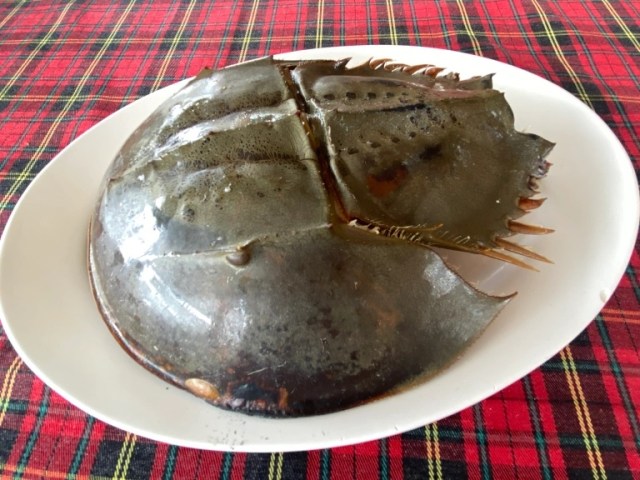
The horseshoe crab’s uniquely coastal taste leaves our reporter unsure whether she hates it or loves it.
Our travel loving reporter Ikuna Kamezawa is currently in Thailand, having recently spent time at a izakaya that served food currently banned in Japan. But having got her fill of Japanese food in Bangkok, she decided to take a trip to somewhere a little more authentically Thai. So a propeller plane, bus and boat ride later, she found herself in Koh Chang, which translates to “Elephant Island” and gets its name because it’s shaped like an elephant’s head.
▼ Koh Chang was a popular tourist spot pre-COVID-19.
Compared to the hustle and bustle of Bangkok, Koh Chang seemed pretty quiet and peaceful, which is exactly why Ikuna had decided to go there. There weren’t any buses or taxis on the island, so Ikuna decided to rent a motorcycle and go on an adventure to a place on the island that she’d heard was pretty good; a ‘floating village’ about 40 minutes south of the harbour.
The road to the floating village was pretty perilous, especially as Ikuna was on a motorcycle. The route had mostly steep roads, and Ikuna almost ended up rolling back down the slopes several times — that’s how steep they were! But eventually she arrived at the water village, called Bang Bao.
There are a bunch of souvenir stores and dive shops in the village, as well as some houses that are connected by an old looking wooden bridge. Ikuna had heard that this village used to be full of tourists, so much so that it was hard to move about, but with the current travel climate, it took Ikuna less than 30 minutes to walk around the whole quaint and charming village and see everything.
Just as she was ready to ride her motorcycle back down the slopes, though, she spotted an inconspicuous yet intriguing-looking restaurant selling something she’d never even dreamed of eating.
Horseshoe crabs!
While horseshoe crabs are delicacies in some Asian countries, Japan is not one of them. Ikuna has never seen a single restaurant menu in Japan that has horseshoe crab on it. In fact, she wasn’t entirely convinced that horseshoe crabs were even edible. She’d always thought of them as ‘living fossils’; something to observe and admire, rather than something she’d find on her plate.
Nevertheless, she ordered a roasted horseshoe crab and waited with excitement.
A horseshoe crab meal cost 800 baht (US$22.14). As this was Ikuna’s first horseshoe crab experience, she wasn’t sure whether that was expensive or not. Either way, seeing as she was in a different country, it only seemed right to treat herself to something she’d not normally encounter in Japan!
The waiter immediately grabbed the horseshoe crab from the tank with his bare hands. While the crabs look pretty intimidating, the tails aren’t used to sting you; instead, they’re used to right themselves if they get turned upside down.
After 15 minutes waiting at the outdoor table, enjoying the sea breeze, Ikuna’s meal arrived.
Ta-da! Roasted horseshoe crab, with a side salad! It was completely different to what Ikuna, who, up until now had only experienced regular old crab, had been expecting. She’d been envisioning that the horseshoe crab would be fairly meaty.
But as she inspected her plate closer, she saw the underbelly of the horseshoe crab was instead covered in knobbly bits. Is this what horseshoe crab meat looks like?
Ikuna asked the waiter, who told her that these were in fact horseshoe crab eggs. Despite the name, horseshoe crabs are actually more closely related to arachnids like spiders. So while actual crabs have lots of meaty flesh to enjoy, horseshoe crabs are mostly eaten for their eggs, or roe.
Ikuna could see a tiny bit of ‘crab-like meat’ on the horseshoe crab, but it was stuck to the shell so tightly that it was pretty inedible. She managed to scrape a bit off to try, but it didn’t taste good. If Ikuna had to describe the taste, it would be “very bad frozen crab cartilage”.
The horseshoe crab roe was very much edible, though, so Ikuna popped some in her mouth…
… and her tastebuds were met with an unusual taste of the coast. In her mouth, waves were crashing against the rocky shore with each bite. Not only that, but the roe had a crunchy texture, too. It felt like Ikuna was eating the centre of a horse mackerel’s eyeball (which she recommends, by the way.)
The more she scraped the roe away, a hidden layer of horseshoe crab innards slowly but surely got revealed. They had a strong taste, and with each bite Ikuna felt like she was becoming one with the crab, merging together in some sort of weird unity.
To bring her back to her senses, Ikuna decided to try the salad. At first, she was a little shocked at its surprisingly sharp flavour, but she soon realised the salad was deliberately strong-tasting to help mask the unusual ocean-y smell of the horseshoe crab.
With the help of the salad, Ikuna eventually managed to polish off the entire roasted horseshoe crab. As she put down her fork, she thought to herself, “I’m never eating this again,” but as time passed, she found herself strangely missing the taste of the rocky shore on her tongue.
Horseshoe crab is sold at various spots across Thailand, so if you’re a fan of seafood (or just like the taste of the beach), give it a try. Ikuna recommends sharing a crab with a group of friends rather than eating the whole thing yourself, as it’s a pretty hefty slog. But after eating something like this giant five-and-a-half pound hamburger (also found in Thailand), a measly horseshoe crab should be a walk in the park.
Images: ©SoraNews24
● Want to hear about SoraNews24’s latest articles as soon as they’re published? Follow us on Facebook and Twitter!
[ Read in Japanese ]

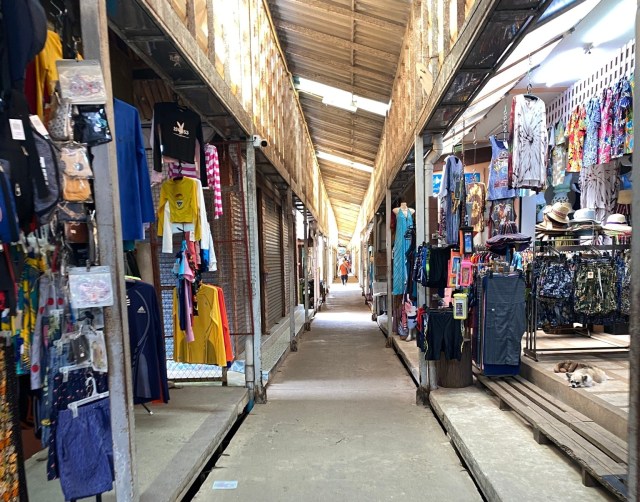
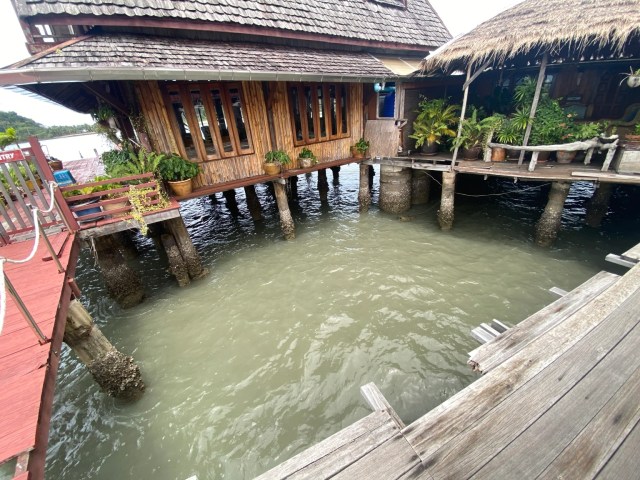
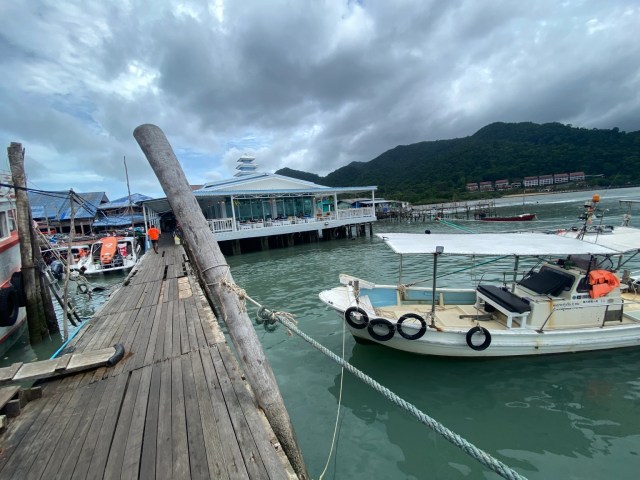
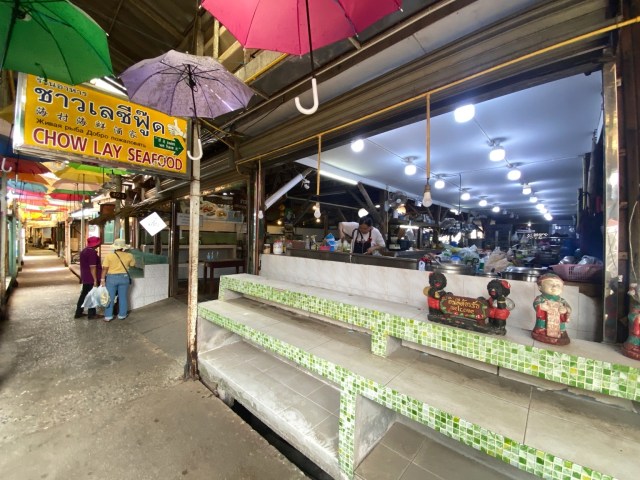
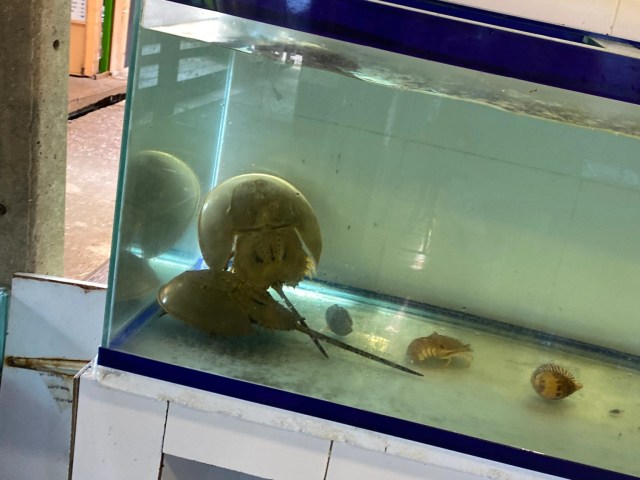
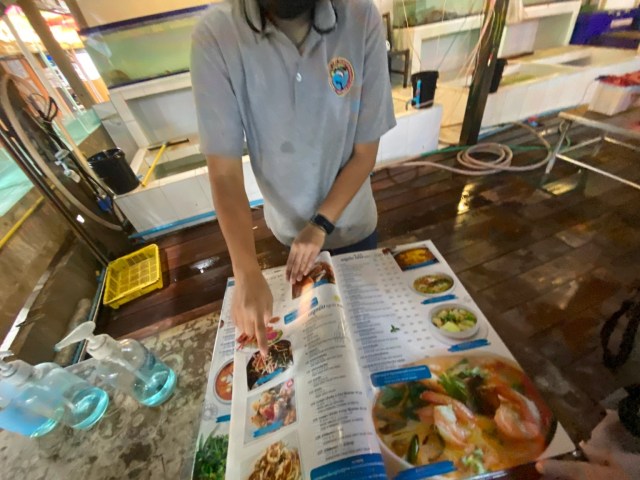
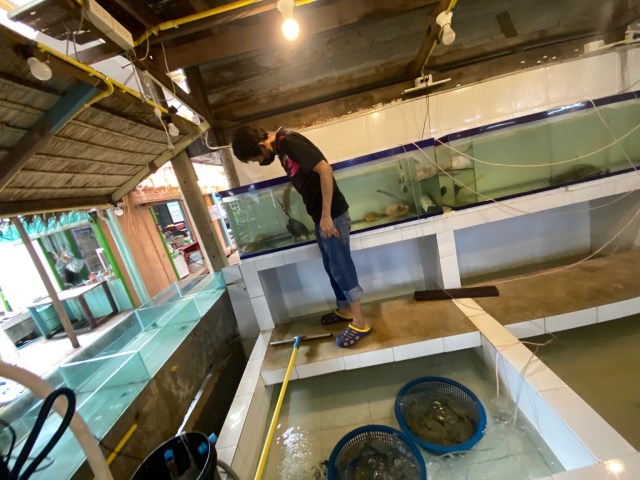
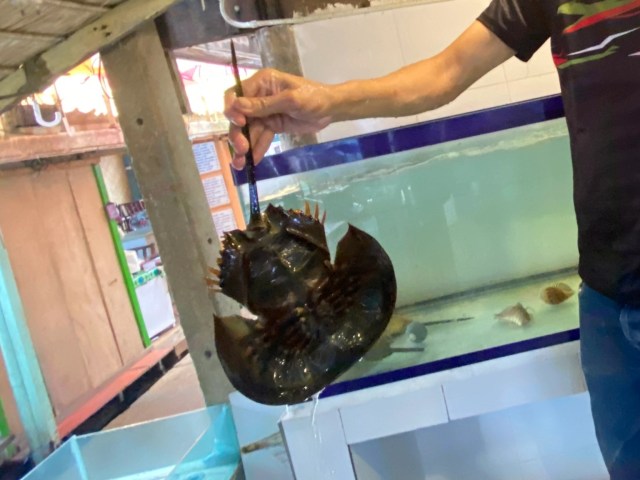
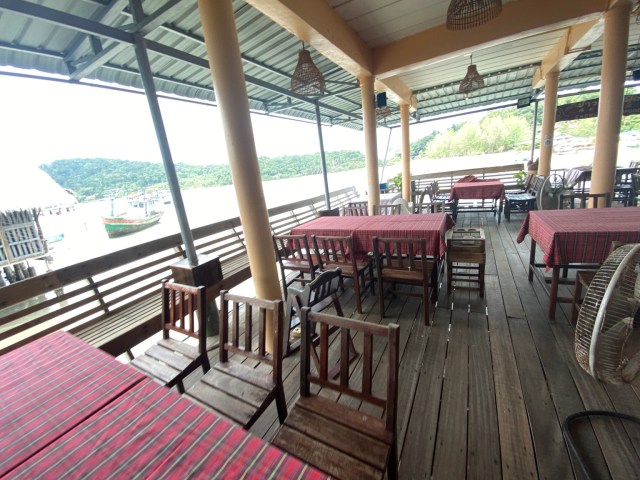
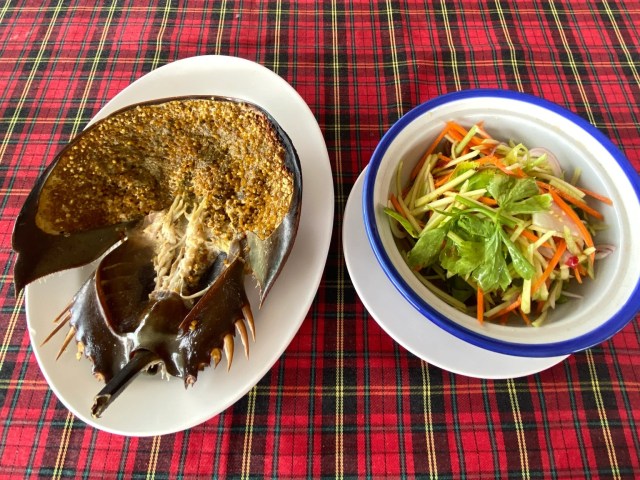
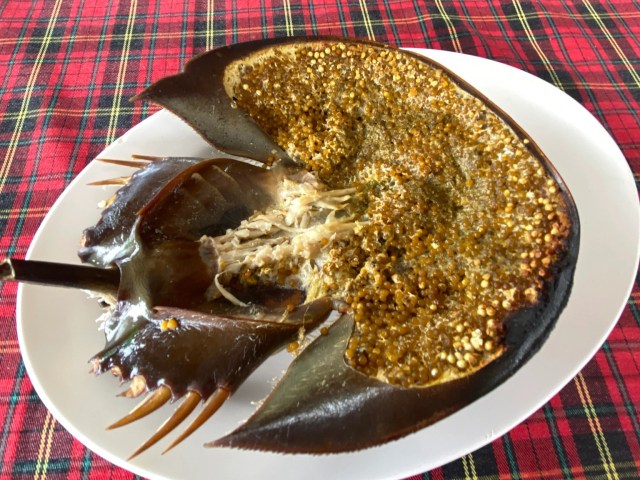
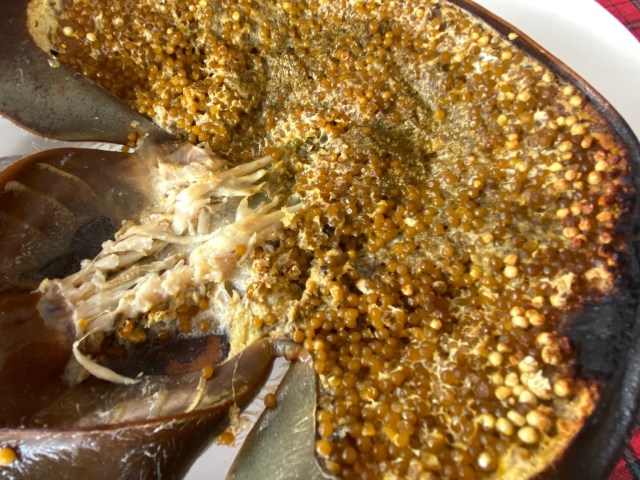
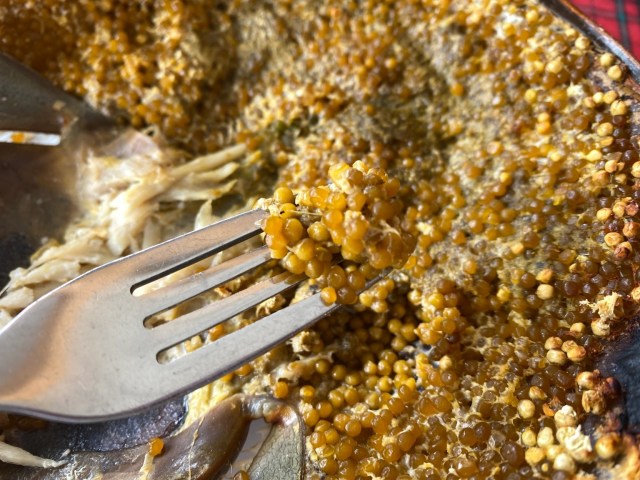
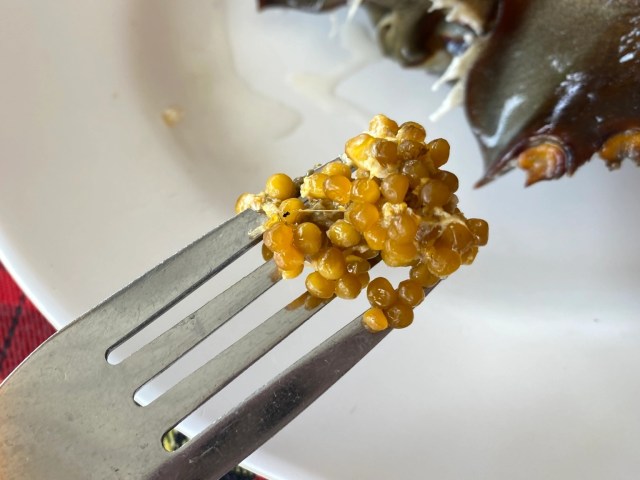
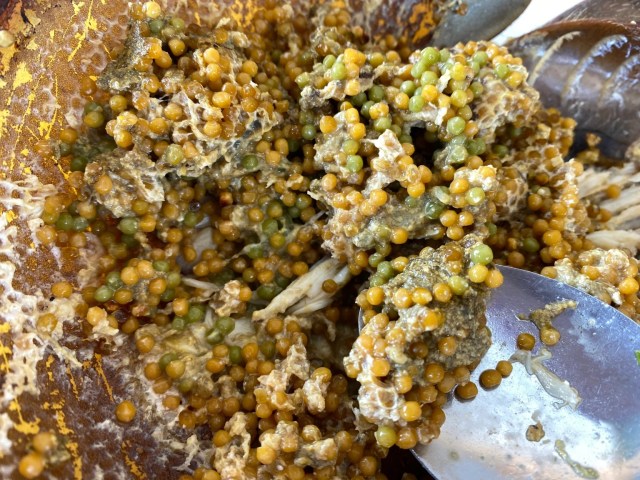
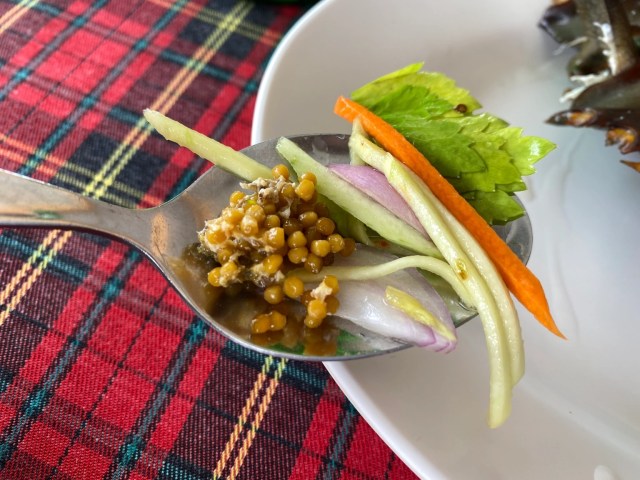
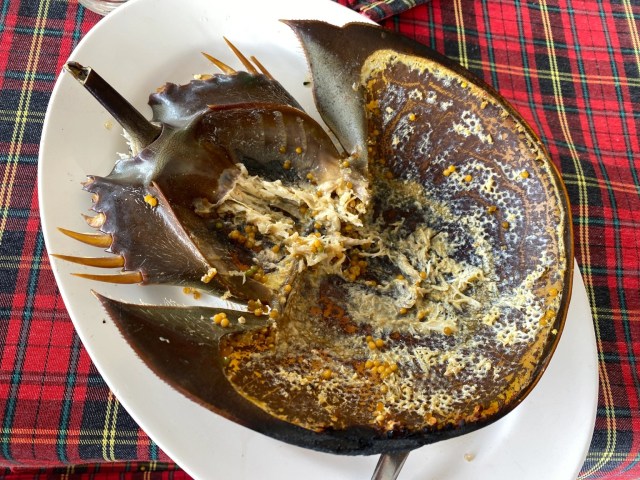
 “Hey Singaporean taxi driver! Take us to the best restaurant in Singapore!”
“Hey Singaporean taxi driver! Take us to the best restaurant in Singapore!” We visit a restaurant called ‘Otaku’ in France, eat some otaku sushi
We visit a restaurant called ‘Otaku’ in France, eat some otaku sushi We try a rotating sushi restaurant in New Delhi, are surprised to find no rotating sushi
We try a rotating sushi restaurant in New Delhi, are surprised to find no rotating sushi The McDonald’s Hokkaido Salmon Burger is a sell-out hit…outside of Japan【Taste test】
The McDonald’s Hokkaido Salmon Burger is a sell-out hit…outside of Japan【Taste test】 We try European Cup Noodle Soba flavors to see which ones come out on top 【Taste test】
We try European Cup Noodle Soba flavors to see which ones come out on top 【Taste test】 How to order snacks on a Shinkansen bullet train in Japan
How to order snacks on a Shinkansen bullet train in Japan Japan’s new difficult-to-drink-from beer glass protects your liver, but it’s a brutal experience
Japan’s new difficult-to-drink-from beer glass protects your liver, but it’s a brutal experience Demon Slayer: Kimetsu no Yaiba gets new roller coaster attractions and food at Universal Studios Japan
Demon Slayer: Kimetsu no Yaiba gets new roller coaster attractions and food at Universal Studios Japan Hello, cosmetics! Clinique teams up with Hello Kitty this summer for first-time collaboration
Hello, cosmetics! Clinique teams up with Hello Kitty this summer for first-time collaboration New Nintendo Lego kit is a beautiful piece of moving pixel art of Mario and Yoshi【Photos】
New Nintendo Lego kit is a beautiful piece of moving pixel art of Mario and Yoshi【Photos】 McDonald’s adds new watermelon frappe and fruity macaron to its menu in Japan
McDonald’s adds new watermelon frappe and fruity macaron to its menu in Japan Burger King Japan suddenly adds Dr. Pepper and Dr. Pepper floats to its menu nationwide
Burger King Japan suddenly adds Dr. Pepper and Dr. Pepper floats to its menu nationwide Doraemon found buried at sea as scene from 1993 anime becomes real life【Photos】
Doraemon found buried at sea as scene from 1993 anime becomes real life【Photos】 Japan Railways now has giant robots performing maintenance work via VR-goggled operators
Japan Railways now has giant robots performing maintenance work via VR-goggled operators Japan’s foreign population reaches historic milestone following largest-ever single-year surge
Japan’s foreign population reaches historic milestone following largest-ever single-year surge Nintendo history you can feel – Super NES, N64, and GameCube controllers become capsule toys
Nintendo history you can feel – Super NES, N64, and GameCube controllers become capsule toys “The most Delicious Cup Noodle in history” – Japan’s French Cup Noodle wins our heart【Taste test】
“The most Delicious Cup Noodle in history” – Japan’s French Cup Noodle wins our heart【Taste test】 Starbucks releases a cute Frappuccino and Unicorn Cake…but not in Japan
Starbucks releases a cute Frappuccino and Unicorn Cake…but not in Japan Kyoto Tower mascot termination reveals dark side behind cute Japanese characters
Kyoto Tower mascot termination reveals dark side behind cute Japanese characters McDonald’s Japan’s Soft Twist Tower: A phantom ice cream only sold at select branches
McDonald’s Japan’s Soft Twist Tower: A phantom ice cream only sold at select branches Yabai Ramen: What makes this Japanese ramen so dangerous?
Yabai Ramen: What makes this Japanese ramen so dangerous? Finally! Nintendo Japan expands Switch 8-bit controller sales to everybody, Online member or not
Finally! Nintendo Japan expands Switch 8-bit controller sales to everybody, Online member or not Japanese government wants to build luxury resorts in all national parks for foreign tourists
Japanese government wants to build luxury resorts in all national parks for foreign tourists To combat declining birth rate, Japan to begin offering “Breeding Visas” to foreigners
To combat declining birth rate, Japan to begin offering “Breeding Visas” to foreigners 10 things you should buy at 7-Eleven in Japan
10 things you should buy at 7-Eleven in Japan Studio Ghibli releases anime heroine cosplay dresses that are super comfy to wear
Studio Ghibli releases anime heroine cosplay dresses that are super comfy to wear Woman charged for driving suitcase without a license in Osaka
Woman charged for driving suitcase without a license in Osaka Studio Ghibli unveils My Neighbour Totoro miniature house model
Studio Ghibli unveils My Neighbour Totoro miniature house model Kyoto experiencing problems with foreign tourists not paying for bus fares, but not on purpose
Kyoto experiencing problems with foreign tourists not paying for bus fares, but not on purpose Fighting mild hunger with a Japanese soda that turns into jelly in the stomach【Taste test】
Fighting mild hunger with a Japanese soda that turns into jelly in the stomach【Taste test】 Studio Ghibli’s Howl’s Moving Castle tapestry unveiled in Japan for first time
Studio Ghibli’s Howl’s Moving Castle tapestry unveiled in Japan for first time McDonald’s new Happy Meals offer up cute and practical Sanrio lifestyle goods
McDonald’s new Happy Meals offer up cute and practical Sanrio lifestyle goods Sales of Japan’s most convenient train ticket/shopping payment cards suspended indefinitely
Sales of Japan’s most convenient train ticket/shopping payment cards suspended indefinitely Sold-out Studio Ghibli desktop humidifiers are back so Totoro can help you through the dry season
Sold-out Studio Ghibli desktop humidifiers are back so Totoro can help you through the dry season Japanese government to make first change to romanization spelling rules since the 1950s
Japanese government to make first change to romanization spelling rules since the 1950s Foreigner’s request for help in Tokyo makes us sad for the state of society
Foreigner’s request for help in Tokyo makes us sad for the state of society Ghibli founders Toshio Suzuki and Hayao Miyazaki contribute to Japanese whisky Totoro label design
Ghibli founders Toshio Suzuki and Hayao Miyazaki contribute to Japanese whisky Totoro label design Tokyo’s most famous Starbucks is closed
Tokyo’s most famous Starbucks is closed Princesses, fruits, and blacksmiths: Study reveals the 30 most unusual family names in Japan
Princesses, fruits, and blacksmiths: Study reveals the 30 most unusual family names in Japan Hey, Thai tuk-tuk driver! Take us to the best Thai restaurant in this part of Bangkok!
Hey, Thai tuk-tuk driver! Take us to the best Thai restaurant in this part of Bangkok! Is that restaurant in Tokyo with the giant mecha crab sign any good?
Is that restaurant in Tokyo with the giant mecha crab sign any good? We visit a ramen bar in Croatia, meet a whole new version of ramen we can’t wait to make at home
We visit a ramen bar in Croatia, meet a whole new version of ramen we can’t wait to make at home Hey, Croatian taxi driver! Take us to the restaurant with the best štrukli in Zagreb
Hey, Croatian taxi driver! Take us to the restaurant with the best štrukli in Zagreb Marine creature-themed tea bags transform teapots into aromatic oceans
Marine creature-themed tea bags transform teapots into aromatic oceans Our reporter orders food from Uber Eats, falls in love, learns that fate works in mysterious ways
Our reporter orders food from Uber Eats, falls in love, learns that fate works in mysterious ways How can you maximize the calories you burn singing karaoke?【Experiment】
How can you maximize the calories you burn singing karaoke?【Experiment】 Ramen and girls bar: Where you can talk to women who aren’t dressed like hosts or maids
Ramen and girls bar: Where you can talk to women who aren’t dressed like hosts or maids We joined the 10,000 otaku who recently congregated in Madrid for Japan Weekend
We joined the 10,000 otaku who recently congregated in Madrid for Japan Weekend Our Japanese reporter visits Czechia’s famous beer spas and boozily bathes in a bath of beer
Our Japanese reporter visits Czechia’s famous beer spas and boozily bathes in a bath of beer Japan’s big eats just got even bigger at this little-known cafe
Japan’s big eats just got even bigger at this little-known cafe McDonald’s breakfast menu in Hong Kong is like nothing we’ve ever seen in Japan
McDonald’s breakfast menu in Hong Kong is like nothing we’ve ever seen in Japan Our Japanese language reporter gets lucky with Vietnam McDonald’s Prosperity Beef Burger
Our Japanese language reporter gets lucky with Vietnam McDonald’s Prosperity Beef Burger We get our hands on a coveted Yodobashi lucky bag, this time the beauty and health gadget box
We get our hands on a coveted Yodobashi lucky bag, this time the beauty and health gadget box This lucky bag of anime models is also a decades-long history lesson for our mecha newbie
This lucky bag of anime models is also a decades-long history lesson for our mecha newbie We stumbled upon “Pudding Street” in Hanoi, so of course we had to investigate
We stumbled upon “Pudding Street” in Hanoi, so of course we had to investigate
Leave a Reply